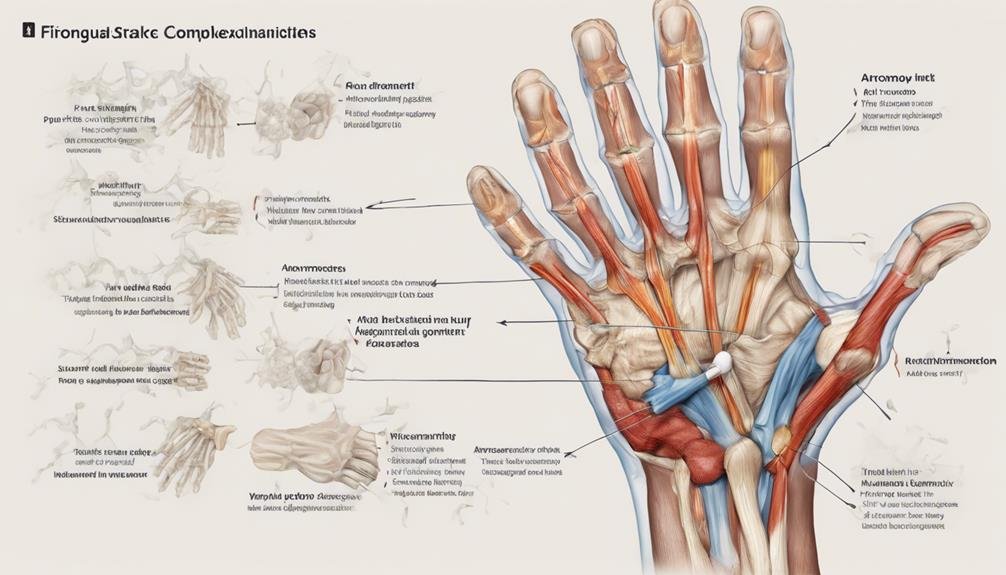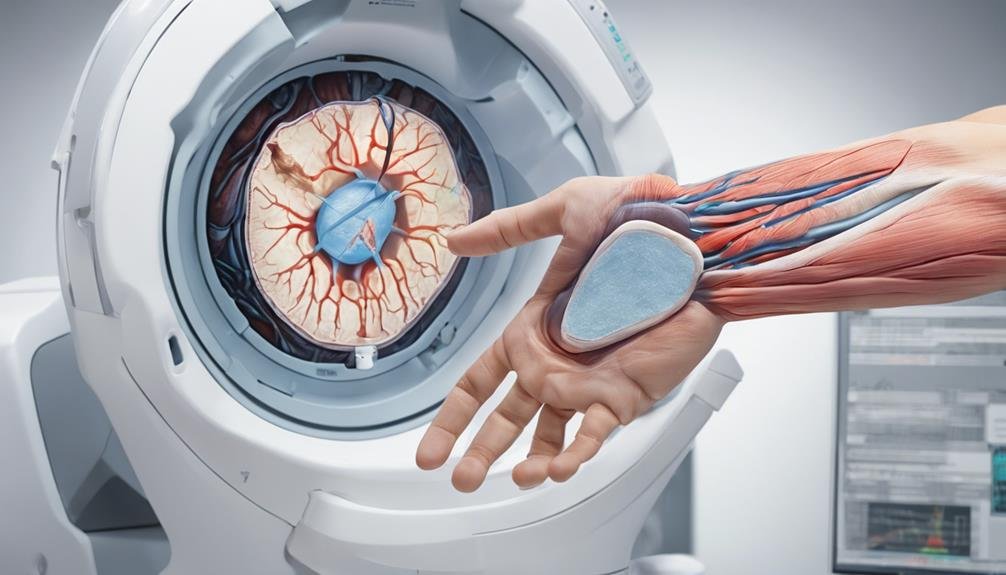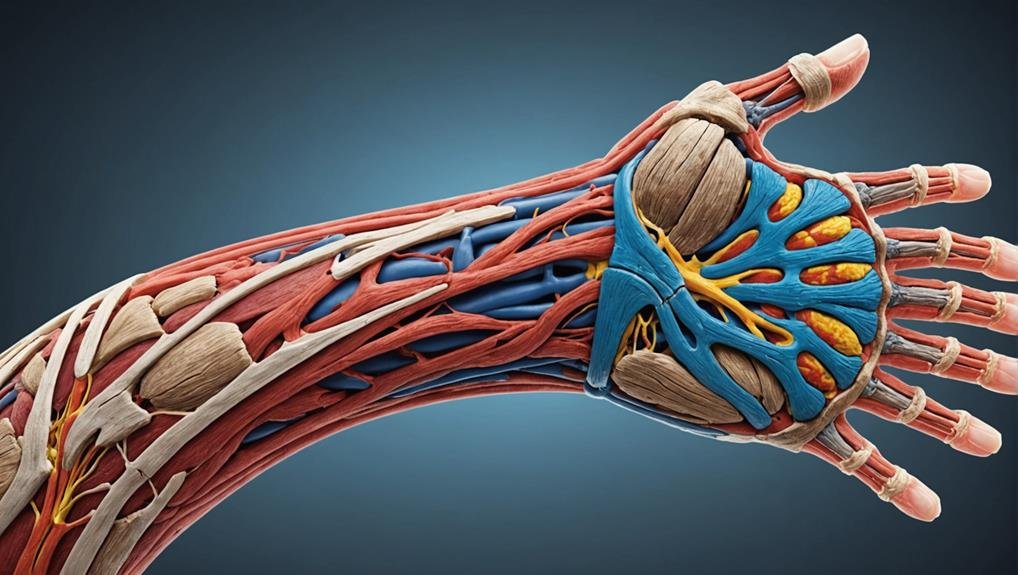Imagine experiencing a sharp, persistent pain in your wrist after a simple fall or a sudden twist. This could be your first encounter with a Triangular Fibrocartilage Complex (TFCC) injury. You might notice a grinding sensation or weakness in your grip, complicating even the simplest tasks. Diagnosing and treating this injury can vary widely, leaving you wondering about the best approach for recovery. With a mix of conservative and surgical options available, how do you determine what’s right for you? Let’s explore further to learn more about managing this complex injury and its impact on your daily life.
Key Takeaways
- TFCC injuries often result from falls on an outstretched hand or repetitive wrist motions.
- Symptoms include wrist pain, stiffness, clicking sounds, and weakness in grip.
- Diagnosis is commonly done through physical exams, MRI, and sometimes arthroscopy.
- Initial treatments involve bracing, physical therapy, and anti-inflammatory medications.
- Recovery can take 12 weeks for conservative treatment or longer with surgery.
Causes and Risk Factors

Pinpointing the key causes and risk factors is pivotal to understanding what leads to a triangular fibrocartilage complex (TFCC) injury. TFCC injuries often occur from falls on an extended hand, a scenario many people encounter in daily life. This sudden impact can tear the complex cartilage structure, leaving the wrist vulnerable.
Over-rotation of the wrist, which is common in various activities, also poses a significant threat to the TFCC. It can occur during specific sports or routine tasks requiring repetitive wrist motions.
Age is another major factor, as tissue degeneration increases susceptibility to TFCC injuries, especially after age 50. The natural wear and tear of tissues over time can weaken the TFCC, making it prone to tears.
Chronic inflammation in the wrist can exacerbate these issues, further increasing the risk of injury. Additionally, sports that demand repetitive wrist actions, like tennis or baseball, can heighten your chances of sustaining a TFCC injury due to their constant strain on your wrist.
Symptoms and Signs
You’ll likely notice wrist pain, stiffness, and reduced range of motion if you’re dealing with a triangular fibrocartilage complex (TFCC) injury. Signs like clicking or popping sounds, especially during wrist movements, can hint at a tear or damage. Watch for weakness in your grip and instability, as these are key indicators of a TFCC tear.
Common Wrist Symptoms
Experiencing a triangular fibrocartilage complex (TFCC) injury often brings specific wrist symptoms that shouldn’t be ignored. You might notice pain on the ulnar side of your wrist, especially when performing everyday activities. This pain can be accompanied by clicking or popping sensations, common when you rotate your wrist. Such symptoms can indicate a significant issue like a central TFCC tear.
A TFCC injury may also reduce the ability to grip objects tightly, challenging tasks requiring wrist strength. You might experience stiffness, resulting in difficulty rotating your wrist. This stiffness can limit your range of motion, affecting your daily routine. Swelling is another symptom to watch out for, as it can further restrict wrist movement.
Here’s a quick overview of common wrist symptoms associated with a TFCC injury:
| Symptom | Description | Effect |
|---|---|---|
| Pain | Ulnar side discomfort | Constant or activity-related |
| Clicking/Popping | Sensations when rotating | Audible and/or palpable |
| Reduced Grip | Difficulty holding objects | Weakness in wrist |
| Stiffness/Swelling | Limited motion and inflamed appearance | Restricts wrist movement |
Understanding these symptoms can help you recognize a potential TFCC injury early, leading to timely treatment and recovery.
Identifying TFCC Tear Signs
Several key indicators can help you identify a TFCC tear. One of the most common signs is ulnar-sided wrist pain, which often feels sharp or aching. You might also notice clicking or popping sounds when you move your wrist, especially during wrist rotation. This can be accompanied by limited wrist motion, making everyday tasks challenging.
Your grip strength may decrease as you try to grip objects, adding to your frustration.
Instability is another sign that shouldn’t be ignored. You might feel as though something is shifting or moving in your wrist, leading to a sensation of instability. Swelling and tenderness on the ulnar side of your wrist can also signal a problem with the fibrocartilage. These symptoms can be particularly pronounced when performing weight-bearing activities or trying to rotate your wrist.
Pay attention to any grinding or catching sensations in your wrist joint, which can further indicate a TFCC tear. Recognizing these TFCC tear signs early is vital for timely diagnosis and preventing long-term issues like chronic pain and reduced wrist function. Don’t hesitate to seek medical advice if you notice these symptoms.
Diagnosis Techniques

You’ll rely on imaging and examination methods when diagnosing Triangular Fibrocartilage Complex (TFCC) injuries. Start with a thorough physical examination and patient history to identify key symptoms and signs.
While X-rays might miss TFCC tears, an MRI or ultrasound can provide a clearer picture, and arthroscopy offers a more invasive option for both diagnosis and treatment.
Imaging and Examination Methods
A combination of advanced imaging techniques and thorough physical examinations is vital for precise identification and treatment planning in diagnosing TFCC injuries. Imaging tests, such as MRI, stand out due to their high sensitivity and specificity in detecting TFCC injury presence. During a physical examination, the ulnar fovea sign and TFCC load test can provide valuable insights into potential injuries.
MRI findings, especially TFCC signal changes or tears, are crucial for forming an accurate diagnosis. They guide the treatment planning process, ensuring the most suitable interventions are considered.
Arthroscopy is a minimally invasive method for visualizing and treating TFCC tears. It’s an effective tool for directly evaluating the damage and determining the extent of the injury. Additionally, triple injection arthrography involves injecting contrast dye to highlight TFCC tears, further enhancing the ability to pinpoint the exact nature of the injury through imaging studies.
Identifying Symptoms and Signs
When identifying symptoms and signs of a TFCC injury, you’ll often notice wrist pain, reduced range of motion, and swelling as primary indicators. These symptoms are typical and can significantly impact your daily activities. You might also experience popping or clicking sounds, particularly revealing signs of a TFCC injury. Clicking sensations during wrist movements often serve as a warning sign, prompting further investigation.
Grip weakness is another symptom that suggests a TFCC injury. When you notice a decrease in grip strength, it’s important to consider a TFCC issue, especially if accompanied by the other symptoms.
Physical examination tests can help pinpoint a TFCC injury. These tests might include specific wrist maneuvers designed to elicit pain or detect instability in the wrist.
X-rays and MRI scans are commonly used to confirm a TFCC injury to confirm a TFCC injury. While X-rays can rule out other conditions, MRI scans provide a detailed view of the soft tissues, making them essential for an accurate diagnosis.
However, diagnosing TFCC injuries can be challenging due to their symptoms overlapping with those of other wrist conditions. Hence, carefully assessing all symptoms, including clicking sensations, is vital for accurate diagnosis and treatment.
Treatment Options
Triangular fibrocartilage complex (TFCC) injuries can be managed through various treatment options, starting with initial steps. When you experience a TFCC tear, the first approaches often involve treatments like bracing, casting, and physical therapy. These methods aim to reduce ulnar deviation and improve wrist function by promoting healing and reducing inflammation. Anti-inflammatory medications can also help alleviate pain associated with the injury.
If these initial treatments don’t resolve the symptoms, you might need to contemplate arthroscopic surgery. This minimally invasive procedure addresses persistent TFCC tears by allowing for debridement or repair. Depending on the tear’s severity, surgical options may include ulnar shortening to correct any anatomical discrepancies contributing to the problem.
Recovery from TFCC surgery involves diligent postoperative care and adherence to rehabilitation protocols. Physical therapy is essential in restoring wrist function and strength, ensuring you regain mobility. The healing process can take up to three months, so following your healthcare provider’s guidance closely is vital.
If initial treatments fail to provide relief, surgical interventions can restore wrist stability and function, helping patients return to daily activities.
Prevention Strategies

One way to shield your wrists from TFCC injuries is to be proactive about preventing them. Start by engaging in wrist-strengthening exercises that help improve stability and minimize the risk of TFCC tears. These exercises are vital for TFCC injury prevention as they fortify the muscles surrounding your wrist, providing better support during various activities.
Incorporate ergonomic techniques into your daily routine. Use proper tools specifically designed to reduce strain on your wrist, whether at work, at home, or enjoying a hobby. Modifying movements that cause discomfort can notably lower the chances of sustaining an injury. Pay attention to how your wrist feels during repetitive tasks and adjust accordingly.
Preventing overuse injuries is another essential aspect of wrist health. To allow your wrist to recover, take regular breaks from activities that stress it. Maintaining a balanced diet and staying hydrated also contribute to overall joint health, including wrist health.
Remember the significance of rest. Giving your wrists adequate time to heal from daily wear and tear is vital for preventing TFCC injuries. Following these strategies can effectively shield your wrists and maintain their health.
Prognosis and Recovery
Recovery from a Triangular Fibrocartilage Complex (TFCC) injury hinges on the severity of the tear and the treatment path you choose. After a diagnosis of TFCC, you might consider either conservative treatment or surgical options.
With conservative treatment, you can expect recovery in up to 12 weeks, focusing on rest, immobilization, and physical therapy. However, surgical options may be necessary for more severe tears, extending recovery time to about three months.
Your prognosis depends on factors such as age, activity level, and how well you adhere to the treatment plan. Younger individuals or those who actively follow rehabilitation protocols often experience better outcomes.
Despite the treatment path, complications like chronic pain, reduced wrist function, and instability can arise if the injury is left untreated or if the rehabilitation process isn’t properly followed.
To maximize recovery and improve wrist function, you should engage fully in rehabilitation protocols post-surgery. These protocols are essential in regaining strength and mobility, allowing you to return to normal activities.
Frequently Asked Questions
What Are the Symptoms of a Triangular Fibrocartilage Complex Injury?
You might experience wrist pain, stiffness, and swelling, which diagnostic tests help confirm. Consider pain management, wrist braces, and rehabilitation exercises: non-surgical treatments and occupational therapy aid recovery. If needed, surgical options exist. Long-term effects vary.
How Do You Treat a TFCC Injury?
You can treat it with rest and ice, wrist splinting, and NSAIDs for pain management. Physical and occupational therapy, cortisone injections, activity modification, platelet-rich plasma therapy, and arthroscopic surgery can also be essential for recovery.
What Happens if a TFCC Tear Goes Untreated?
If you leave a tear untreated, long-term consequences include complications and impact on daily activities. Risk factors rise, leading to possible surgical options. Non-surgical treatments, like bracing and physical or occupational therapy, are critical in rehabilitation.
Should a TFCC Tear Be Splinted or Cast?
Considering surgical intervention or non-surgical options, you should evaluate whether splinting or casting is suitable. Depending on risk factors, arthroscopic surgery might be necessary, followed by rehabilitation exercises and occupational and physical therapy, which can impact the recovery timeline and long-term effects.
Conclusion
In dealing with a TFCC injury, you must understand the causes, symptoms, and diagnosis methods. Treatment can be as simple as bracing or as involved as surgery, depending on severity. Please don’t underestimate the importance of rehabilitation, as it’s vital to a successful recovery. While you can’t always prevent these injuries, being mindful of your wrist’s limits and taking precautions can help. With proper care, you can regain strength and restore function to your wrist.

